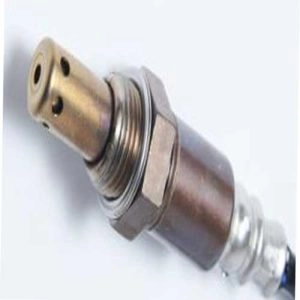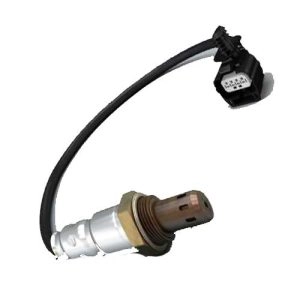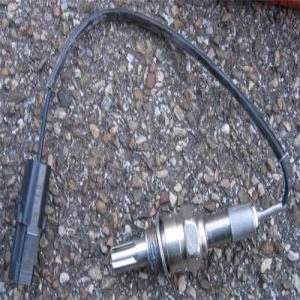The exhaust sensor, also known as the oxygen sensor, is used to monitor the level of unburned oxygen emitted from the exhaust and to observe the amount and ratio of burned fuel. The sensor also contributes to reducing the amounts of unburned fuel and lowering the emission of harmful nitrogen oxide gas, which is detrimental to the environment.
The exhaust sensor is part of the exhaust system and contains a heating circuit. Its function is to reduce the time it takes for it to reach the appropriate working temperature after the engine has started. The exhaust sensor may also contain wires ranging from one to four. Sensors with three or four wires include a heater, while sensors with one or two wires do not require heating.
In addition to the above, a zirconium lamp is used, placed at the end of the sensor, and is coated with platinum, acting as electrical poles for ventilating the internal part, while the external part is exposed to hot gases emitted from the exhaust. Voltage is produced as a result of the difference in oxygen levels between the exterior part and the zirconium lamp.
After 1996, all cars manufactured require an exhaust sensor for each pollution canister in the exhaust system. Most cars nowadays have two or four sensors. Unburnt fuel pollution leads to the spread of hydrocarbons in the air, while nitrogen oxide spreads as a result of too much air in the fuel mixture within the combustion chamber; when its temperature exceeds 700 degrees.
In this article, we will discuss the exhaust sensor, explain how it works, and highlight the main signs indicating its damage.
How the Exhaust Sensor Works

Initially, a car emits many gases that contain several elements harmful to the environment, due to the combustion of the air-fuel mixture in the engine cylinders. At this point, the exhaust sensor tracks the oxygen level in the exhaust gases as they pass through the pollution control unit to determine the amount of fuel burnt by the engine. The sensor then sends the data it has gathered to the car's computer, which uses it to adjust the fuel injection timing. This is done to maintain the best possible ratio of air and fuel within the engine, ensuring the normal operation of the engine and the car.
Also read:5 Symptoms Indicate Coil Damage
What are the symptoms of oxygen sensor damage in a car?

The exhaust sensor is an essential part of the engine, and its damage leads to problems in the internal combustion process. Over time, the ash from oil emissions can impact it and reduce its ability to assess and monitor the mixture. Therefore, we will mention signs of oxygen sensor damage to watch out for:
Firstly: The engine light appears.
The oxygen sensor greatly affects the combustion of fuel and air. If there is an increase or decrease in the proportion of oxygen in the exhaust gases after combustion, the car's computer will attempt to correct the anomaly and restore the situation to normal. However, if the sensor is defective, the computer will not be able to solve the problem, which leads to a decrease in engine performance and the appearance of the engine light on the settings panel. Typically, remember that the illumination of the engine light on the dashboard occurs as a result of several issues and problems, it is not limited to the damage of this sensor only.
Secondly: Increased fuel consumption
Damage to the oxygen sensor can lead to an imbalance in the fuel-air mixture within the combustion chamber of the engine, resulting in increased fuel consumption. This causes the car to consume more fuel than usual, and you will be forced to refill the fuel tank in a shorter period than usual.
Thirdly: Sputtering and stalling of the engine.
When the car is stationary but the engine is still running, its rotations are in idle mode and are approximately 1000 revolutions per minute (rpm). However, if the engine's rpm fluctuates between 2000 and 3000, this indicates a problem with the engine. A possible cause could be a faulty oxygen sensor, among other reasons.
Fourthly: Combustion interference and performance weakness.
When interference occurs in the normal combustion process of the engine, its performance will decline. This usually happens when there is a damaged oxygen sensor, so you will notice that the car's acceleration capability is poor, and there will be a general weakness in engine performance.
Fifthly: Failure in the periodic inspection due to the carbon ratio.
The exhaust sensor in the exhaust system can help control car emissions. If your car cannot pass the periodic inspection due to high carbon levels, this could be due to damage to the exhaust sensor.
When should the exhaust sensor be changed?

Over time, oil ash, lead and sulfur residues, and fuel additives accumulate on the oxygen sensor, preventing it from transmitting data to the car's computer. Additionally, sometimes using inappropriate fuel for your car or low-quality fuel can damage the sensor more quickly. Typically, the sensor should be replaced.Exhaust SensorAfter traveling 100,000-150,000 km as a precautionary measure to maintain engine performance and reduce pollution levels, however, if you aren't experiencing any issues, there would be no need to change it.
Finally, it is necessary to change the sensors in pairs when the engine has four sensors, for example, both the right and left sensors should be replaced together when changing one of them to avoid triggering fault codes.

Comments